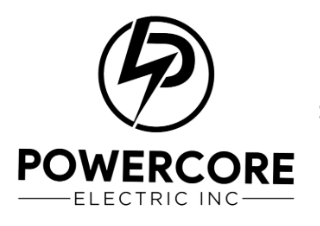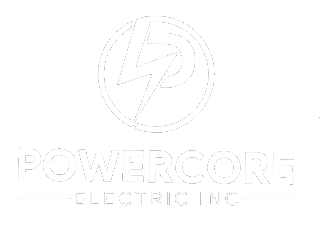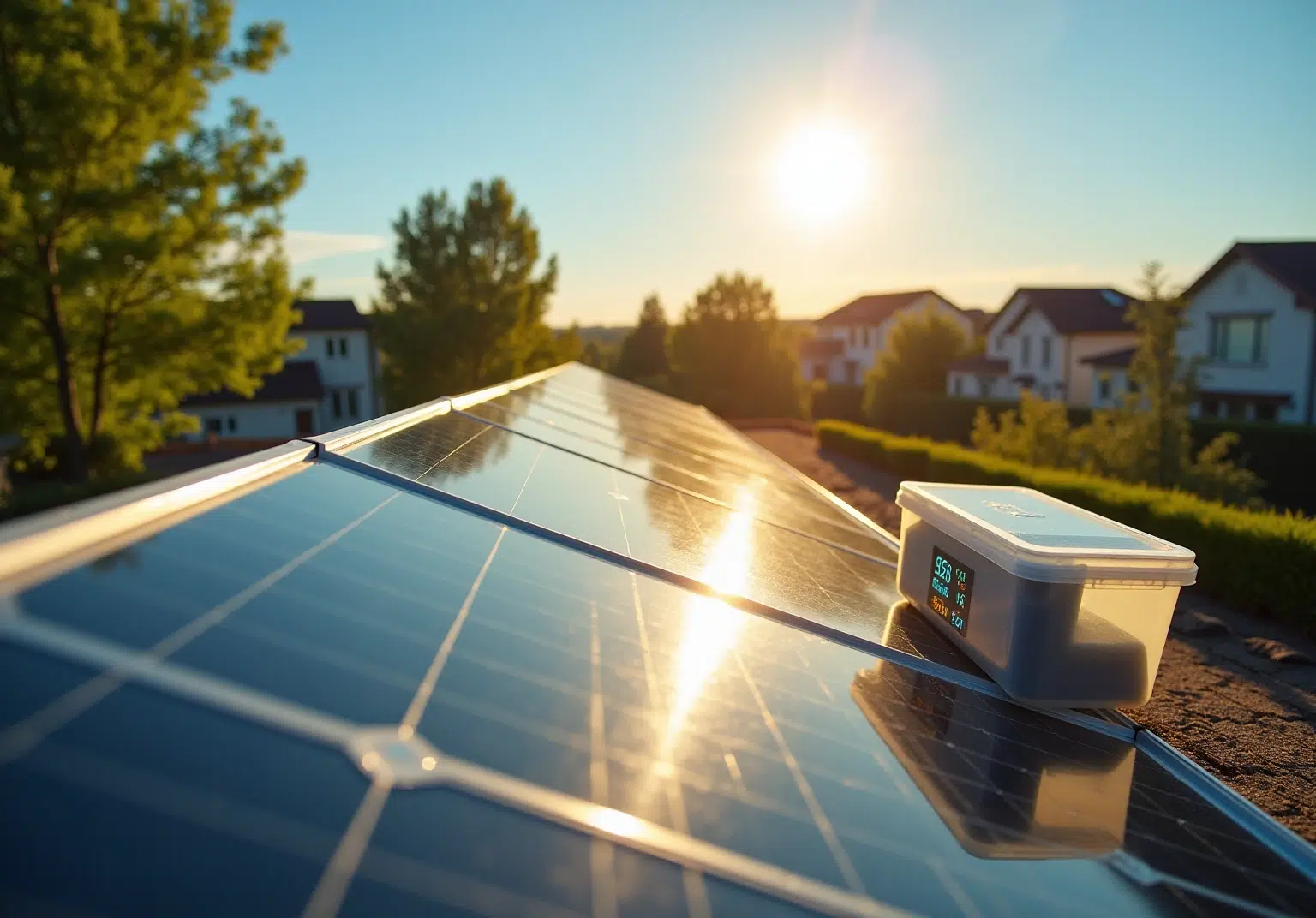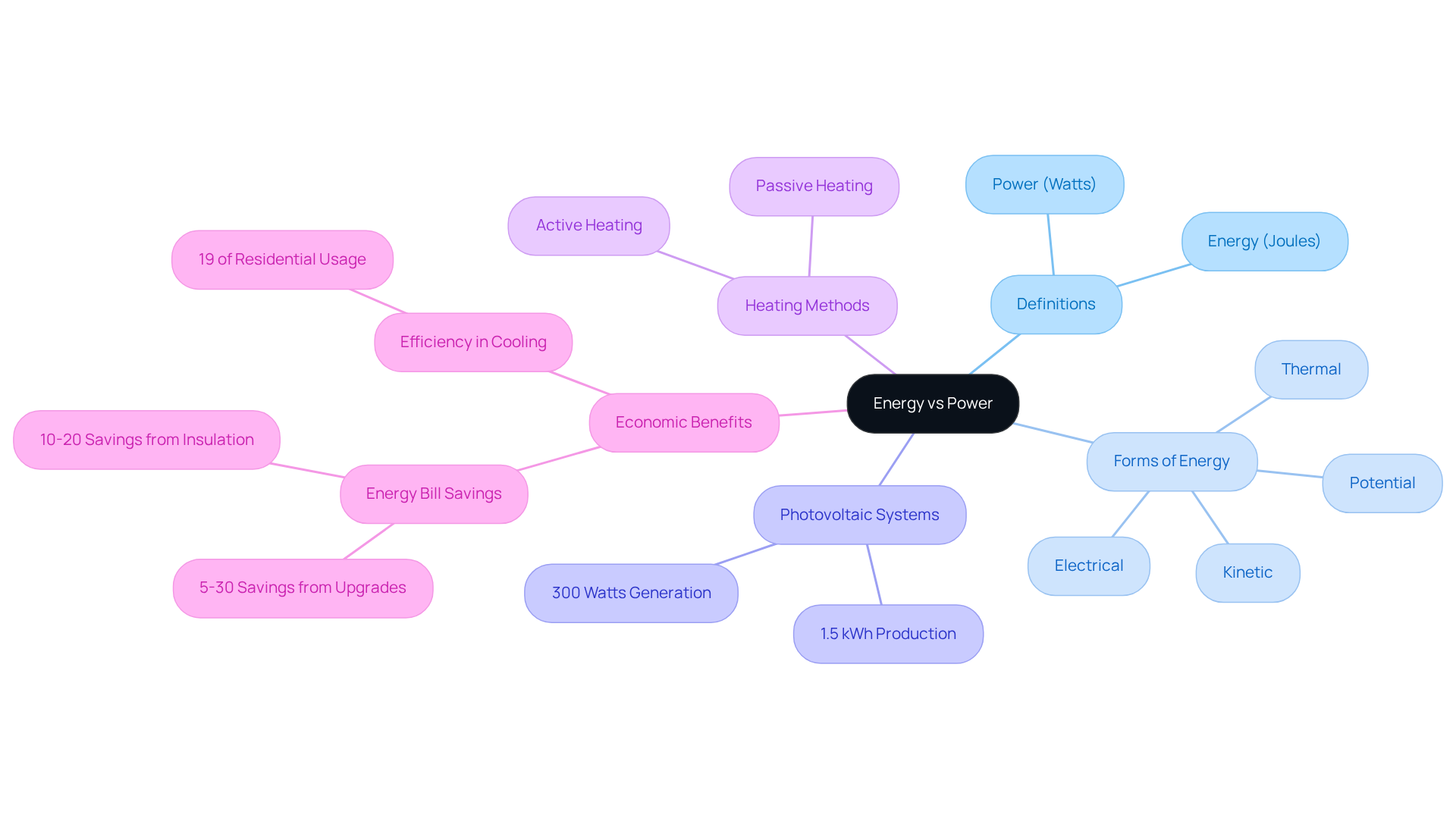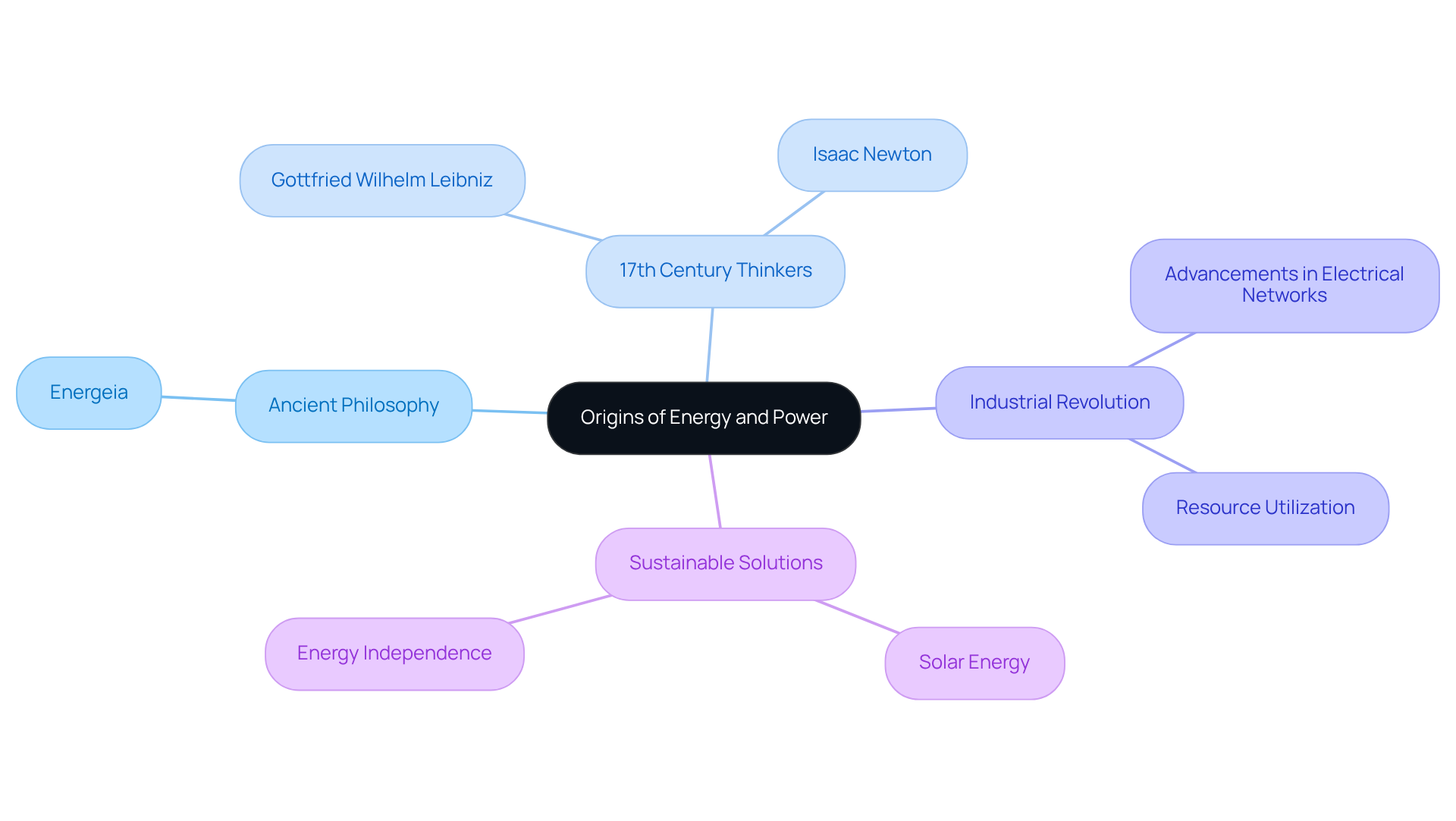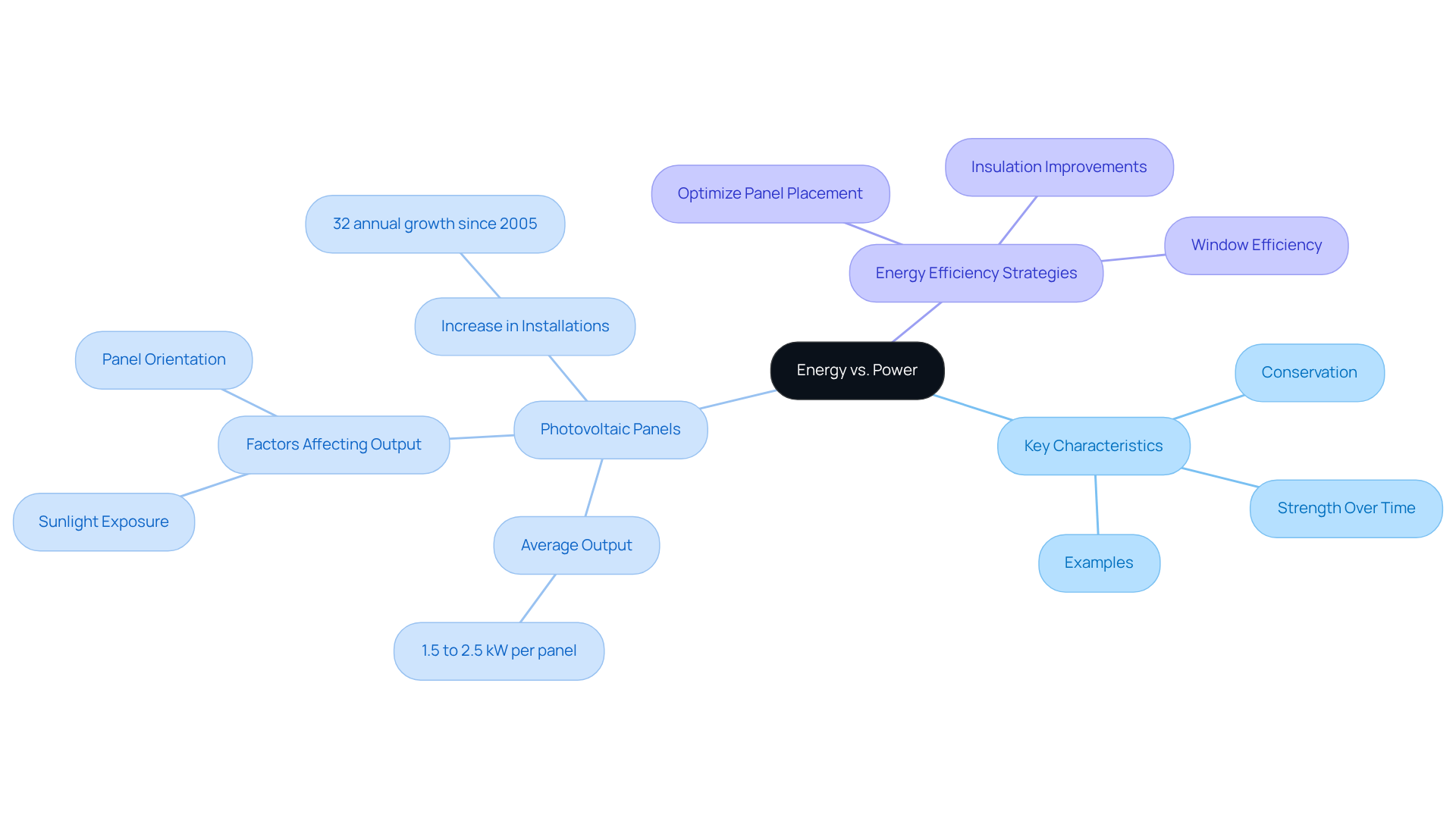Overview
We understand that rising energy bills can be a significant concern for homeowners. Energy, defined as the capacity to perform work and measured in joules, is a concept that directly impacts your daily expenses. Power, on the other hand, is the rate at which that work is done, measured in watts. This distinction is crucial for grasping how renewable energy systems, such as photovoltaic panels, can operate efficiently. By illustrating practical examples of energy consumption and generation, we highlight the importance of both concepts in optimizing energy use and reducing costs for you.
Imagine harnessing the sun’s energy to power your home, leading to greater energy independence and a reduction in those daunting bills. It’s common to feel overwhelmed by these challenges, but together we can explore sustainable solutions that not only benefit your finances but also contribute to a healthier planet.
Let’s work towards a future where you feel empowered and supported in your energy choices. If you’re ready to take the next step towards energy independence, we’re here to guide you every step of the way.
Introduction
In today’s world, where sustainable practices are becoming increasingly vital, understanding the distinction between energy and power is essential. We know that rising energy bills can be a source of stress for many homeowners, prompting the need for efficient solutions.
- While energy represents the capacity to perform work,
- power measures the rate at which that work is done.
This makes the two concepts interdependent yet fundamentally different.
How can a clearer grasp of these concepts enhance energy efficiency in our homes? What practical steps can we take together to optimize energy use and reduce costs?
This article explores the key differences between energy and power, delving into their implications for our everyday lives and sustainable practices. Together, we can navigate these challenges and work towards a more energy-independent future.
Define Energy and Power: Core Concepts
The difference between energy and power lies in the fact that energy is the capacity to perform work or induce change, quantified in joules (J). It appears in various forms, such as kinetic, potential, thermal, and electrical forces. Conversely, the difference between energy and power is illustrated by strength, which is the rate at which work is transferred or converted, measured in watts (W), where one watt equals one joule per second. This differentiation is especially vital in renewable sources, particularly with the rising utilization of photovoltaic installations, where both resources and capacity greatly affect design and operational effectiveness.
We understand that energy bills can be a significant concern for many homeowners. In California, the average household consumes approximately 10,632 kilowatt-hours (kWh) of electricity annually, translating to about 38 million joules per day. This consumption emphasizes the importance of comprehending usage trends and enhancing electricity generation, particularly with the growing implementation of photovoltaic technologies. For instance, a standard photovoltaic panel setup can generate approximately 300 watts of electricity under ideal circumstances, efficiently transforming sunlight into practical resources.
Practical examples illustrate this relationship: a photovoltaic panel generating 300 watts for five hours produces 1,500 watt-hours, or 1.5 kWh, equating to about 5.4 million joules. This conversion highlights the significance of both energy and power in optimizing the efficiency of photovoltaic installations, allowing homeowners to understand the difference between energy and power while utilizing clean energy effectively and decreasing dependence on conventional power sources.
It’s common to feel overwhelmed when evaluating heating solutions. Homeowners should recognize the two main types: active and passive heating methods. Active systems utilize pumps and controls to circulate heat transfer fluids, while passive systems rely on building design and materials to optimize heat absorption. Grasping these differences is crucial for choosing the optimal solar heating option that corresponds with personal power requirements and local climate conditions. Moreover, homeowners can reduce 5-30% on their utility bills through home resource evaluations, highlighting the financial advantages of understanding power and consumption. Considering that air conditioning represented 19% of residential site electricity usage in 2020, emphasizing efficiency in cooling methods is especially pertinent in California’s climate. Additionally, adequate insulation and air sealing can result in savings of 10-20% compared to pre-upgrade consumption, demonstrating practical uses of efficiency strategies.
Together, we can make a difference. Powercore Electric’s community-focused strategy aligns with these initiatives, guaranteeing that homeowners receive tailored assistance in their transition to sustainable power practices, including insights into the economic and environmental advantages of solar heating systems. Let’s work towards a cleaner, more efficient future together.
Trace the Origins of Energy and Power: Historical Context
We understand that concerns about rising energy bills can weigh heavily on your mind. The concept of power has a rich history, tracing back to ancient philosophy, with roots in the Greek term ‘energeia,’ which means ‘activity’ or ‘operation.’ In the 17th century, thinkers like Gottfried Wilhelm Leibniz and Isaac Newton began to shape our modern understanding of power as an independent force. This understanding became increasingly significant during the industrial revolution, a time when the demand for effective resource utilization was paramount.
Imagine how this period spurred the advancement of electrical networks in the late 19th century, enabling the widespread use of electricity in homes and industries alike. This transformation not only changed usage habits but also laid the groundwork for the infrastructures we rely on today. The industrial revolution profoundly influenced our understanding of the difference between energy and power, and it’s common to feel both awe and concern about how these developments impact our lives now.
As we reflect on our energy habits, it’s essential to consider the benefits of embracing sustainable solutions like solar energy. Together, we can work towards energy independence, reducing reliance on traditional power sources and ultimately easing the burden of those energy bills. If you’re ready to explore how these solutions can benefit you, let’s take that step together. Your journey towards a more sustainable and empowered energy future starts now.
Identify Key Characteristics: Energy vs. Power
We understand that energy bills can be a significant concern for homeowners. Energy is characterized by its ability to exist in various forms and its principle of conservation, highlighting the difference between energy and power, as it cannot be created or destroyed, only transformed. In contrast, the difference between energy and power is characterized by strength, which is assessed over time and indicates how resources are utilized or generated. For example, a photovoltaic panel may produce a certain quantity of electricity, measured in kilowatt-hours, throughout a day, while its instantaneous output, measured in kilowatts, indicates how much electricity it generates at any given moment. This distinction is crucial for comprehending the difference between energy and power in the context of efficiency and system design in renewable applications.
It’s common to feel overwhelmed by the options available, but real-world instances demonstrate the benefits of embracing solar energy. In California, photovoltaic panels generally generate an average power output of approximately 1.5 to 2.5 kilowatts per panel under ideal conditions. This output can vary based on factors such as sunlight exposure and panel orientation. Significantly, the quantity of U.S. residences with installed photovoltaic panels has increased by an average of 32% annually since 2005, emphasizing the rising acceptance of renewable solutions and the advantages of government programs that assist homeowners in utilizing these technologies.
Together, we can enhance the effectiveness of renewable power solutions by focusing on conservation principles, such as optimizing photovoltaic panel placement and utilizing efficient devices. Specialists highlight that concentrating on efficient enhancements, such as adequate insulation and high-performance windows, can greatly decrease power usage, resulting in reduced utility costs and enhanced comfort in residences. In fact, an estimated 10-25% of an average household heating and cooling bill escapes through leaks associated with windows, underscoring the importance of addressing these issues. Furthermore, Soolyeon Cho, Ph.D., observes that numerous efficient upgrades are quite economical and offer instant savings, rendering them a worthwhile investment for homeowners aiming to enhance their renewable power installations.
Let’s work towards a more sustainable future together, where your energy independence is within reach.
Examine Real-World Examples: Energy and Power in Action
We understand that rising energy bills can be a significant concern for many homeowners. A residential photovoltaic setup offers a meaningful solution by transforming sunlight into electrical power, providing a pathway to energy independence. Solar panels capture sunlight and convert it into electricity, which can then be stored in batteries for later use. The electricity generated by these panels is quantified in kilowatt-hours (kWh), while the immediate output is measured in kilowatts (kW). For instance, a photovoltaic setup may produce roughly 30 kilowatt-hours of electricity over a day, with its output varying throughout the day, reaching around 5 kilowatts during midday. This dynamic connection between vitality and strength illustrates the difference between energy and power, which is essential for maximizing resource use and ensuring reliability in domestic utility systems.
Additionally, the typical storage capacity of home batteries usually varies from 10 to 15 kilowatt-hours, enabling homeowners to store surplus power for use during peak demand or outages. Real-world installations, such as those by Powercore Electric, demonstrate how effective power storage solutions enhance independence and reliability, addressing the growing concerns of rising electric bills and power disruptions.
It’s common to feel overwhelmed by the expense of setting up a photovoltaic system, which can fluctuate considerably, usually falling between $15,000 and $30,000, based on the dimensions and kind of system. However, this investment can lead to significant savings on electricity costs over time, making renewable power a financially practical option compared to conventional electricity sources.
Are you ready to transition to renewable energy? Together, we can explore what solar energy can do for you. Contact Powercore Electric today to receive your free, personalized estimate and take the first step towards a more sustainable future.
Conclusion
We understand that navigating the complexities of energy consumption and the rising costs of energy bills can be overwhelming. Understanding the distinction between energy and power is crucial for making informed decisions about energy consumption and sustainability. Energy, defined as the capacity to perform work, and power, the rate at which that work is done, play vital roles in both our daily lives and the broader context of renewable energy solutions. This knowledge empowers homeowners to optimize their energy usage, especially as the shift towards renewable resources like solar energy becomes increasingly relevant.
Throughout this discussion, we have explored key insights, including:
- The various forms of energy
- The historical context of power
- Practical examples of how these concepts are applied in real-world scenarios
The importance of energy efficiency, particularly in the context of photovoltaic systems, cannot be overstated. By understanding these principles, you can lead to significant cost savings on your energy bills. Furthermore, community initiatives and tailored assistance play a pivotal role in helping you transition to more sustainable energy practices.
Ultimately, embracing the knowledge of energy and power not only enhances your understanding but also contributes to a collective movement towards sustainability. Together, we can consider renewable energy options and implement efficiency strategies that allow you to take significant steps toward reducing your energy costs and environmental impact. The journey towards a cleaner, more efficient future is not just a personal endeavor but a shared responsibility that can lead to lasting change in energy consumption patterns. Let’s work towards this brighter future together.
